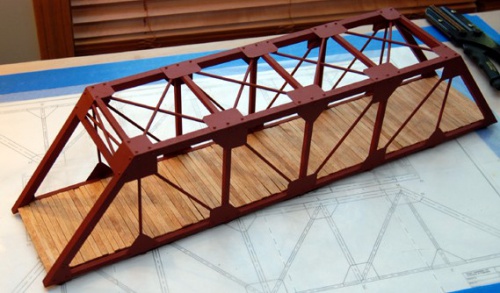Build a Model Bridge out of Manila Folders
Manila Folders can be used to cost effectively make an attractive, functional model railroad bridge in N, HO, S, and O scales if built sufficiently strong and also with good structure.
Steps
- Design your bridge. Use real-life bridges for design ideas. Determine the gap you need to span, how wide the bridge needs to be, and how much you need to clear your rolling stock. At each joint between two members use a gusset plate.
- Draw it out on graph paper, because you will use your drawing to lay out the pieces later. Take care to determine which structural members will carry the most weight, either via tension (the bottom) or compression (the top) and make those wider than others that might not necessarily carry as much weight. Vertical member can be half as wide as horizontal members, and diagonal members can be two parallel vertical strips.
- Count out and draw an appropriate number of members on an opened up file folder. You will be making a cardboard tube for each member. Remember to double the number for two trusses. Make sure to have 5 sides, 4 plus a gluing flap.
- Cut out and mark the dimensions on each piece. Use a ballpoint pen to draw the fold lines, and press hard to as to "score" the fold line.
- Fold the member into a cardboard tube, and use rubber cement to glue it. It will take some practice, but you will eventually figure out a process that you can use to make strong members. Rub off the excess rubber cement once it has dried.
- Tape the graph paper plan to a large flat surface. If you do not have a large desk you can clear off, a piece of plywood works well. Tape wax paper on top of that.
- Begin laying out your bridge. Start with the gusset plates, then your diagonal stringers, then the tube members, then the other side of stringers. On the upper layer of stringers, leave one excess length.
- Glue on the gusset plates working from one end of the bridge to the other, pulling the stringers taut as you go.
- Once the glue has dried enough, trim the excess stringer with an X-acto knife.
- Allow the assembly to dry overnight.
- Pull the truss off the wax paper carefully. Don't worry about tearing the wax paper.
- Tape down another piece of wax paper and repeat to build second truss.
- Set the trusses up side by side and determine the width of the bridge.
- Make more tubes to connect each vertex to its corresponding vertex on the other truss.
- Use more strips to make an X-pattern on the top, this adds side-to-side stability.
- Set up your track through the bridge and test run a train through it. Look for members that want to buckle along the bottom.
- Add layers of glue and manila to these weak places.
- Use a flat matte black spray paint to protect the bridge from moisture.
- Set up the bridge over your model gully, river, or ravine and have fun watching trains traverse your span!
Tips
- Let everything dry for a couple of days to reduce the risk of collapse. Once dry the bridge will hold a surprising amount of weight.
- Be patient. You will not be able to build a nice looking bridge in one sitting.
- Look to real-life bridges for design ideas. Pay attention to how the trusses are connected to each other.
Warnings
- Before permanently installing the bridge, load test it. This will prevent much aggravation later.
- Be careful with knives and scissors.
- Don't run your prized rolling stock over an untested bridge, especially in larger scales.
Things You'll Need
- Manila Folders
- Rubber Cement
- Wax Paper
- Ruler
- Pencils
- White Glue
- Graph Paper
- Scissors
- X-Acto Knife
- Ballpoint pen
- Matte Black spray paint
Related Articles
- Build a Model Bridge out of Skewers
- Prep and Paint Cast Resin Models
- Make a Miniature Treehouse
